Sets: Difference between revisions
imported>Teltura (Manually fixing formatting for imported article.) |
No edit summary |
||
| Line 1: | Line 1: | ||
'''Sets''' | '''Sets''' are collections of cards released together in a single batch. Sets normally have various themes or mechanics that cards emphasize in an effort to give the set an identity and focus. | ||
There are three major kinds of sets: '''base''' sets, '''expansion''' sets, and '''supplemental''' sets. For example: | |||
* [[The Return of the King]] (set 7) is the '''base''' for [[King Block]], as it establishes the King Block site path, reprints cards from earlier sets that are necessary workhorse cards for the new block, and otherwise lays the foundations of the new block's identity. | |||
* [[Siege of Gondor]] (set 8) and [[Mount Doom]] (set 10) are '''expansions''' for King Block, building on ROTK's foundation and pushing the limits further. | |||
* [[Reflections]] (set 9) is a '''supplemental''' set, which cannot be used on its own and instead introduces small groups of special cards which must be injected into some other block. | |||
{{ | Each block was defined as one tentpole set and two expansions, with supplemental sets cropping up here and there as necessity demanded. The [[Promotional]] set (set 0) was a special supplemental set which repeatedly had new cards added to it which were reprints of cards from other sets, usually with alternate images or foiling or handed out in special circumstances. | ||
Initially, official [[Decipher]] sets were centered around the movies that they were released with and named after: sets 1-3 around [[The Fellowship of the Ring]], sets 4-6 around [[The Two Towers]], and 7/8/10 around [[The Return of the King]]. This era is appropriately dubbed [[Movie Block]]. | |||
In November 2004 the new base set, [[Shadows]], marked a turning point in the game in more ways than one. For the first time, a single set would have cards with imagery and concepts drawn from all three movies, forcing the sets to forge their own identity in something other than plot. In addition, Decipher reworked several core mechanics of the game, including introducing a more dynamic [[Site Path]] and reorganizing the [[Shadow]] [[Cultures]] along different lines. These changes were controversial, and created a permanent rift between the Movie era and everything that came after. | |||
{| class="wikitable" | |||
|+ Sets | |||
|- | |||
! style="text-align:center" | Block !! style="text-align:center" | # !! Name !! style="min-width: 150px" | Release Date !! Size !! style="text-align:center" | Cultures Introduced !! Notes | |||
|- | |||
| rowspan="3" | [[Fellowship Block]] || 1 || [[The Fellowship of the Ring]] || 6 November, 2001 || 365 standard + 365 [[Foil]] + 3 [[Oversized]] + 15 [[Tengwar]] || {{C|Dwarven}}, {{C|Elven}}, {{C|Gandalf}}, {{C|Gondor}}, {{C|Isengard}}, {{C|Moria}}, {{C|Sauron}}, {{C|Ringwraith}}, {{C|Shire}} || Established the baseline of the game. | |||
|- | |||
| 2 || [[Mines of Moria]] || 6/13 March 2002 || 122 standard + 122 [[Foil]] + 4 [[Oversized]] + 3 [[Tengwar]] || - || Introduced [[Artifacts]] as well as the long-awaited [[Balrog]] | |||
|- | |||
| 3 || [[Realms of the Elf-lords]] || 19 June / 3 July 2002 || 122 standard + 122 [[Foil]] + 2 [[Oversized]] || - || Introduced Saruman and various infamous cards such as {{Card|Flaming Brand}} and {{Card|Heir to the White City}}. | |||
|- | |||
| rowspan="3" | [[Towers Block]] || 4 || [[The Two Towers]] || 6 November, 2002 || 365 standard + 365 [[Foil]] + 2 [[Oversized]] + 14 [[Tengwar]] || {{C|Dunland}}, {{C|Raider}}, {{C|Rohan}} || Established a new [[Towers Block]] site path. Introduced Ithilien [[Ranger]]s, [[Easterling]]s, and the split between [[unbound]] and [[Ring-bound]] companions, as well as [[Fortification]]s and [[Machine]]s | |||
|- | |||
| 5 || [[Battle of Helm's Deep]] || 12 March 2003 || 128 standard + 128 [[Foil]] + 2 [[Oversized]] + 4 [[Tengwar]] || {{C|Gollum}} || Introduced both Smeagol and Gollum. The 3 random rares in [[Starter Decks]] were replaced with fixed rares, which also had alternate image reprints in [[Booster Packs]]. | |||
|- | |||
| 6 || [[Ents of Fangorn]] || 2 July 2003 || 128 standard + 128 [[Foil]] + 3 [[Oversized]] + 1 [[Tengwar]] || - || Introduced viable [[Ent]] companions. Continued the fixed rares in Starter Decks. | |||
|- | |||
| rowspan="2" | [[King Block]] || 7 || [[The Return of the King]] || 5 November 2003 || 365 standard + 365 [[Foil]] + 1 [[Oversized]] + 7 [[Tengwar]] || - || Established the [[King Block]] site path. Introduced the mechanics of [[Initiative]] and [[Threats]], and reintroduced [[Fortification]]s and [[Engine]]s. Added Morgul Orcs to the {{C|Ringwraith}} culture. | |||
|- | |||
| 8 || [[Siege of Gondor]] || 10 March, 2004 || 122 standard + 122 [[Foil]] + 6 [[Tengwar]] || - || Introduced [[Corsair]]s, {{C|Gondor}} [[Wraith]]s, and Shelob. Also introduced the [[Enduring]] keyword and the concept of [[Culture Tokens]]. This set is commonly noted as the point where [[Power Creep]] began to rear its ugly head. | |||
|- | |||
| - || 9 || [[Reflections]] || 12 May 2004 || 52 [[Foil]] || - || Introduced [[Alternate Ring-bearers]] besides just Frodo and included many Weta-designed concepts that never made it to filming, such as {{Card|Tom Bombadil}}, {{Card|Radagast, The Brown}} and {{Card|The Red Arrow}}. Also included Second Age characters as playable companions, such as Gil-galad and Elendil. | |||
|- | |||
| [[King Block]] || 10 || [[Mount Doom]] || 14 July, 2004 || 122 standard + 122 [[Foil]] + 5 [[Tengwar]] || - || Introduced self-healing [[Enduring]] [[Nazgul]], {{C|Sauron}} [[Troll]]s, and such infamous cards as {{Card|Galadriel, Lady Redeemed}} and {{Card|Cirdan, the Shipwright}}. | |||
|- | |||
| rowspan="3" | [[War of the Ring Block]] || 11 || [[Shadows]] || 3 November 2004 || 266 standard + 18 RF [[Legends]] + 6 [[Tengwar]] || {{C|Men}}, {{C|Orc}}, {{C|Uruk-hai}}, {{C|Wraith}} || Established the [[Shadows]] site path, doing away with numbered sites. Restructured all [[Shadow]] [[Cultures]] to follow racial lines rather than faction ones. Introduced the [[Resistance]] mechanic to replace [[Signets]] on Companions. | |||
Starting with this set, sets no longer had a parallel diffraction [[Foil]] set alongside the normal one. Instead, Rare Foil (RF) [[Legends]] cards would be selected among the highlights of the set. | |||
|- | |||
| 12 || [[Black Rider]] || 18 March 2005 || 194 standard + 18 RF [[Legends]] + 9 [[Legends Masterworks]] + 6 [[Tengwar]] || - || Reprinted many workhorse cards from [[The Fellowship of the Ring]] that had been lost with the introduction of [[rotation]] into [[Standard]]. | |||
In addition to RF [[Legends]] cards, a selection of those Legends would be reprinted an additional time as [[Legends Masterworks]], which were foil and received an alternate template for their culture (first used in the [[Countdown Collection]]). | |||
|- | |||
| 13 || [[Bloodlines]] || 12 August 2005 || 194 standard + 18 RF [[Legends]] + 9 [[Legends Masterworks]] + 6 [[Tengwar]] || - || Introduced [[Followers]] to address the vacuum left by [[Allies]]. | |||
This set marks the last edge of stability before the effects of Decipher's financial troubles began to truly impact the company's output. From here quality control issues and major delays plague set releases. | |||
|- | |||
| - || 14 || [[Expanded Middle-earth]] || 17 February 2006 || 15 standard || - || Introduced more [[Weta]]-designed cards in the form of a draft pack. | |||
|- | |||
| [[Hunters Block]] || 15 || [[The Hunters]] || 9 November 2006 || 194 standard + 18 RF [[Legends]] + 9 [[Legends Masterworks]] || - || Introduced the [[Hunter]] keyword, which often proved to be powerful enough to make characters without it obsolete. | |||
|- | |||
| - || 16 || [[The Wraith Collection]] || 26 August 2006 || 6 [[Foil]] || - || A stop-gap measure in the face of major set delays, this pack included various non-[[Nazgul]] [[Wraith]]s, including [[Weta]]-designed Barrow-Wraiths. | |||
|- | |||
| rowspan="2" | [[Hunters Block]] || 17 || [[Rise of Saruman]] || 1 March 2007 || 148 standard + 18 RF [[Legends]] + 9 [[Legends Masterworks]] || - || Includes a {{C|Rohan}} version of Aragorn, the only multi-cultural Companion, and no less than 5 versions of Saruman. Riddled with errors and balance issues, rumor has it that this set and the next were produced by a single individual, the last designer on Decipher's payroll. | |||
|- | |||
| 18 || [[Treachery & Deceit]] || May 2007 || 140 standard + 18 RF [[Legends]] + 9 [[Legends Masterworks]] || - || Rushed to print in time to beat the expiration of Decipher's license, this set and the previous one had very low print runs and remain rare to this day. This set had several errata issued almost immediately to cover oversights, one of which rendered {{Card|Frenzy of Arrows}} to be literally unplayable. | |||
|- | |||
| - || 19 || [[Age's End]] || June 2007 || 40 [[Foil]] || - || Squeaking in right up to the finish line, this final farewell set included versions of every major character as a last hurrah, as well as an ill-timed introduction of a [[Fellowship]] keyword. | |||
|} | |||
{{Set Table}} | |||
Revision as of 05:46, 20 November 2021
Sets are collections of cards released together in a single batch. Sets normally have various themes or mechanics that cards emphasize in an effort to give the set an identity and focus.
There are three major kinds of sets: base sets, expansion sets, and supplemental sets. For example:
- The Return of the King (set 7) is the base for King Block, as it establishes the King Block site path, reprints cards from earlier sets that are necessary workhorse cards for the new block, and otherwise lays the foundations of the new block's identity.
- Siege of Gondor (set 8) and Mount Doom (set 10) are expansions for King Block, building on ROTK's foundation and pushing the limits further.
- Reflections (set 9) is a supplemental set, which cannot be used on its own and instead introduces small groups of special cards which must be injected into some other block.
Each block was defined as one tentpole set and two expansions, with supplemental sets cropping up here and there as necessity demanded. The Promotional set (set 0) was a special supplemental set which repeatedly had new cards added to it which were reprints of cards from other sets, usually with alternate images or foiling or handed out in special circumstances.
Initially, official Decipher sets were centered around the movies that they were released with and named after: sets 1-3 around The Fellowship of the Ring, sets 4-6 around The Two Towers, and 7/8/10 around The Return of the King. This era is appropriately dubbed Movie Block.
In November 2004 the new base set, Shadows, marked a turning point in the game in more ways than one. For the first time, a single set would have cards with imagery and concepts drawn from all three movies, forcing the sets to forge their own identity in something other than plot. In addition, Decipher reworked several core mechanics of the game, including introducing a more dynamic Site Path and reorganizing the Shadow Cultures along different lines. These changes were controversial, and created a permanent rift between the Movie era and everything that came after.
| Block | # | Name | Release Date | Size | Cultures Introduced | Notes |
|---|---|---|---|---|---|---|
| Fellowship Block | 1 | The Fellowship of the Ring | 6 November, 2001 | 365 standard + 365 Foil + 3 Oversized + 15 Tengwar | Established the baseline of the game. | |
| 2 | Mines of Moria | 6/13 March 2002 | 122 standard + 122 Foil + 4 Oversized + 3 Tengwar | - | Introduced Artifacts as well as the long-awaited Balrog | |
| 3 | Realms of the Elf-lords | 19 June / 3 July 2002 | 122 standard + 122 Foil + 2 Oversized | - | Introduced Saruman and various infamous cards such as Flaming Brand (2R32)
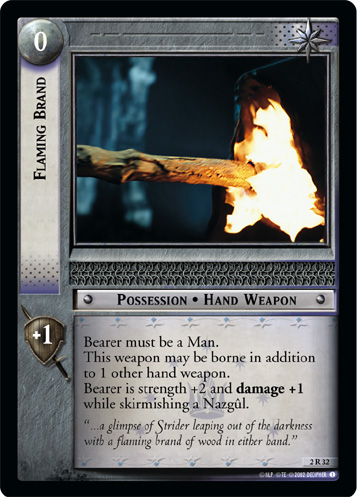 and Aragorn, Heir to the White City (3R38)
and Aragorn, Heir to the White City (3R38)
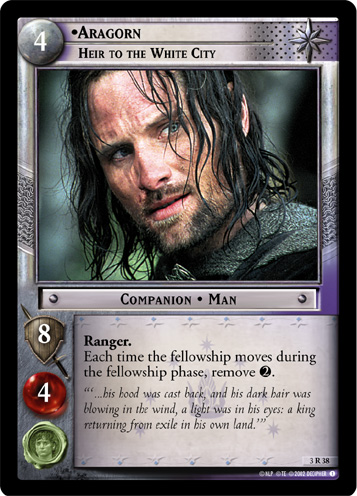 .
.
| |
| Towers Block | 4 | The Two Towers | 6 November, 2002 | 365 standard + 365 Foil + 2 Oversized + 14 Tengwar | Established a new Towers Block site path. Introduced Ithilien Rangers, Easterlings, and the split between unbound and Ring-bound companions, as well as Fortifications and Machines | |
| 5 | Battle of Helm's Deep | 12 March 2003 | 128 standard + 128 Foil + 2 Oversized + 4 Tengwar | Introduced both Smeagol and Gollum. The 3 random rares in Starter Decks were replaced with fixed rares, which also had alternate image reprints in Booster Packs. | ||
| 6 | Ents of Fangorn | 2 July 2003 | 128 standard + 128 Foil + 3 Oversized + 1 Tengwar | - | Introduced viable Ent companions. Continued the fixed rares in Starter Decks. | |
| King Block | 7 | The Return of the King | 5 November 2003 | 365 standard + 365 Foil + 1 Oversized + 7 Tengwar | - | Established the King Block site path. Introduced the mechanics of Initiative and Threats, and reintroduced Fortifications and Engines. Added Morgul Orcs to the |
| 8 | Siege of Gondor | 10 March, 2004 | 122 standard + 122 Foil + 6 Tengwar | - | Introduced Corsairs, | |
| - | 9 | Reflections | 12 May 2004 | 52 Foil | - | Introduced Alternate Ring-bearers besides just Frodo and included many Weta-designed concepts that never made it to filming, such as Tom Bombadil, The Master (9R+52)
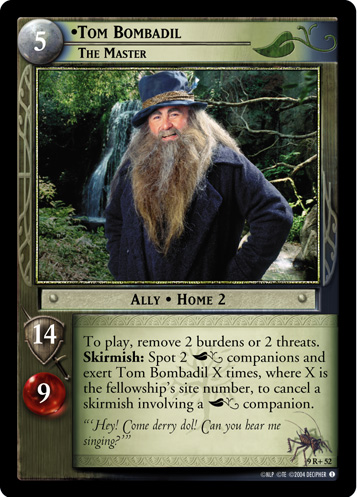 , Radagast, The Brown (9R+26)
, Radagast, The Brown (9R+26)
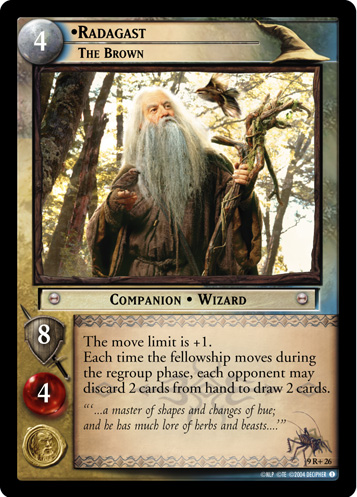 and The Red Arrow (9R46)
and The Red Arrow (9R46)
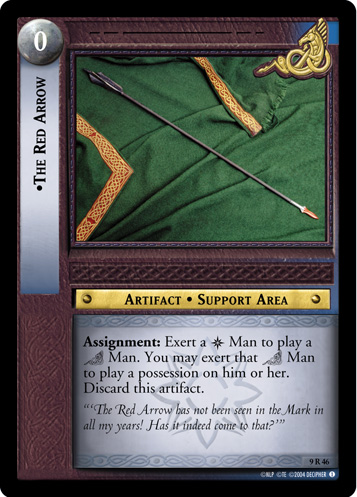 . Also included Second Age characters as playable companions, such as Gil-galad and Elendil.
. Also included Second Age characters as playable companions, such as Gil-galad and Elendil.
|
| King Block | 10 | Mount Doom | 14 July, 2004 | 122 standard + 122 Foil + 5 Tengwar | - | Introduced self-healing Enduring Nazgul, 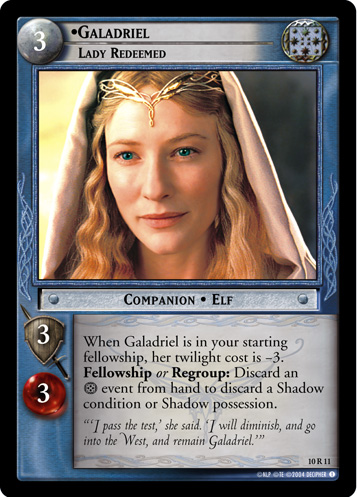 and Círdan, The Shipwright (10R8)
and Círdan, The Shipwright (10R8)
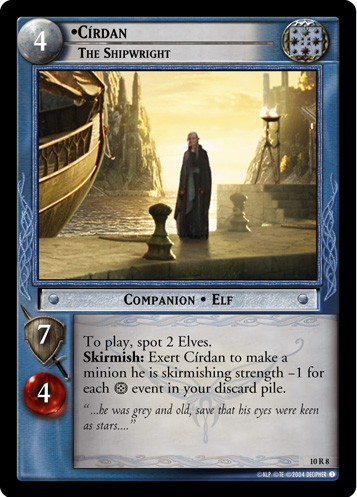 .
.
|
| War of the Ring Block | 11 | Shadows | 3 November 2004 | 266 standard + 18 RF Legends + 6 Tengwar | Established the Shadows site path, doing away with numbered sites. Restructured all Shadow Cultures to follow racial lines rather than faction ones. Introduced the Resistance mechanic to replace Signets on Companions.
Starting with this set, sets no longer had a parallel diffraction Foil set alongside the normal one. Instead, Rare Foil (RF) Legends cards would be selected among the highlights of the set. | |
| 12 | Black Rider | 18 March 2005 | 194 standard + 18 RF Legends + 9 Legends Masterworks + 6 Tengwar | - | Reprinted many workhorse cards from The Fellowship of the Ring that had been lost with the introduction of rotation into Standard.
In addition to RF Legends cards, a selection of those Legends would be reprinted an additional time as Legends Masterworks, which were foil and received an alternate template for their culture (first used in the Countdown Collection). | |
| 13 | Bloodlines | 12 August 2005 | 194 standard + 18 RF Legends + 9 Legends Masterworks + 6 Tengwar | - | Introduced Followers to address the vacuum left by Allies.
This set marks the last edge of stability before the effects of Decipher's financial troubles began to truly impact the company's output. From here quality control issues and major delays plague set releases. | |
| - | 14 | Expanded Middle-earth | 17 February 2006 | 15 standard | - | Introduced more Weta-designed cards in the form of a draft pack. |
| Hunters Block | 15 | The Hunters | 9 November 2006 | 194 standard + 18 RF Legends + 9 Legends Masterworks | - | Introduced the Hunter keyword, which often proved to be powerful enough to make characters without it obsolete. |
| - | 16 | The Wraith Collection | 26 August 2006 | 6 Foil | - | A stop-gap measure in the face of major set delays, this pack included various non-Nazgul Wraiths, including Weta-designed Barrow-Wraiths. |
| Hunters Block | 17 | Rise of Saruman | 1 March 2007 | 148 standard + 18 RF Legends + 9 Legends Masterworks | - | Includes a |
| 18 | Treachery & Deceit | May 2007 | 140 standard + 18 RF Legends + 9 Legends Masterworks | - | Rushed to print in time to beat the expiration of Decipher's license, this set and the previous one had very low print runs and remain rare to this day. This set had several errata issued almost immediately to cover oversights, one of which rendered Frenzy of Arrows (18U79)
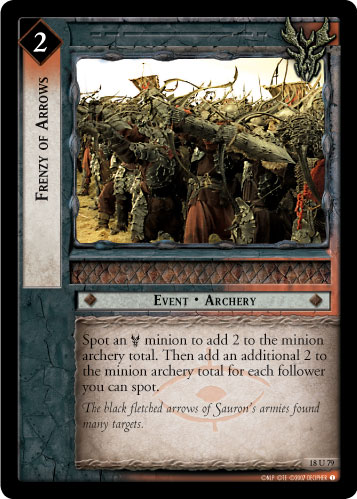 to be literally unplayable.
to be literally unplayable.
| |
| - | 19 | Age's End | June 2007 | 40 Foil | - | Squeaking in right up to the finish line, this final farewell set included versions of every major character as a last hurrah, as well as an ill-timed introduction of a Fellowship keyword. |